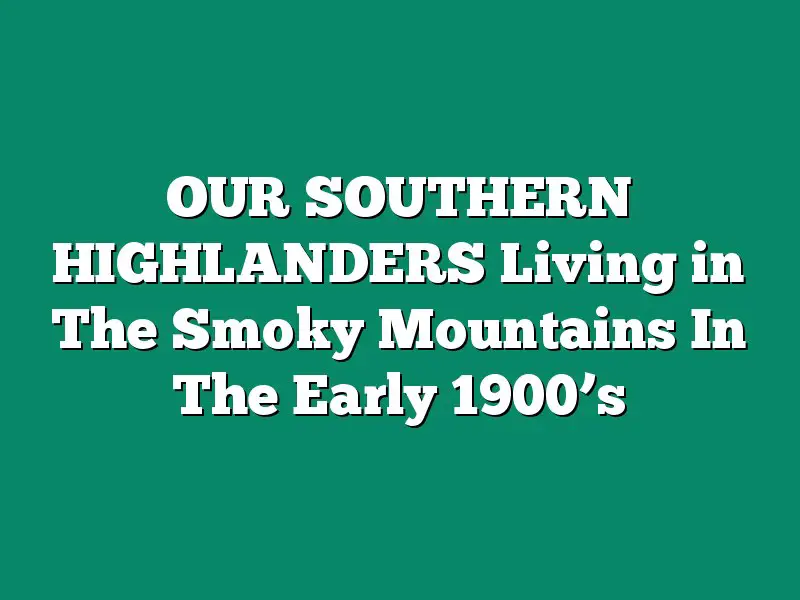Published in 1913 Our Southern Highlanders is a free book you can read online or download it to your pc or Kindle to read. I started reading it yesterday and am finding reading of this time in history and the people who lived in the great Smokies range really fascinating. Really interesting to see how folks lived back then. Wikipedia shares what each chapter is about.
Chapter I, “Something Hidden; Go and Find It,” discusses the remoteness and ruggedness of the Southern Appalachian Mountains, the lack of realistic literature regarding its inhabitants, and gives a brief history of the region.
Chapter II, “The Back of Beyond,” gives a description of Medlin and discusses how the mountaineers have adapted to their environment, the difficulties in farming the rugged terrain, and grazing in the highland meadows.
Photograph from Chapter IV showing bear hunters and quarry
Chapter III, “The Great Smoky Mountains,” discusses the topography, geology, wildlife and plant life of the Great Smokies range. Kephart also relates a story by a “Mr. and Mrs. Ferris” who ventured across the nearly-impassable crest of the central and eastern Smokies to Mount Guyot in search of plant specimens. He also discusses the harshness of the highland meadows, and recounts a story of 17 cattle freezing to death at Silers Meadow.
Chapter IV, “A Bear Hunt In the Smokies,” recounts a bear hunt undertaken by Kephart and several Hazel Creek natives. The party includes Granville Calhoun, a Bone Valley resident named Bill Cope (“the hunchback”), John Baker “Little John” Cable, Jr. (1855–1939), Matt Hyde, and Andrew Jackson “Doc” Jones (1851–1935).[9] The chapter begins at Hall cabin amidst a windstorm and ends with the successful killing of a bear. This chapter contains one of the earliest references to the Appalachian folk song Cumberland Gap.
Chapter V, “Moonshine Land,” discusses Kephart’s initial curiosity about moonshining, and recounts one mountaineer’s justification for the practice.
Chapter VI, “Ways That Are Dark,” continues Kephart’s discussion of moonshining, particularly how it is made in Southern Appalachia, the typical size and settings of stills, etc.
Chapter VII, “A Leaf from the Past,” traces the roots of moonshining to the British Isles, and explains how the practice made its way to Southern Appalachia.
Chapter VIII, “Blockaders and the Revenue,” discusses the ongoing conflict between moonshiners and federal revenue agents.
The Hazel Creek Trail approaching the former site of Medlin
Chapter IX, “The Snake-Stick Man,” tells the story of a federal revenue agent whom Kephart calls “Mr. Quick” (an alias). Quick, who has a hobby of carving sticks into the form of snakes, has a polymathic expertise that Kephart finds most impressive. He is in the area to investigate illegal liquor sales at the nearby Cherokee Reservation.
Chapter X, “A Raid Into the Sugarlands,” recounts a manhunt led by “Mr. Quick” into the Sugarlands, a remote valley south of Gatlinburg on the Tennessee side of the Smokies. The chapter includes an anachronistic story about a mountaineer named “Jasper Fenn” (based on a real-life Sugarlander named Davis Bracken, who lived near what is now the Chimneys Campground)[8][10] who claimed to have read a copy of Our Southern Highlanders given to him by the Pi Beta Phi settlement school in Gatlinburg.
Chapter XI, “The Killing of Hol Rose,” recounts the killing of revenuer James Holland “Hol” Rose by J.E. “Babe” Burnett and Burnett’s subsequent trial.
Chapter XII, “The Outlander and the Native,” discusses the mountaineers’ attitudes toward outsiders.
Chapter XIII, “The People of the Hills,” describes the mountaineers’ typical physical traits, work ethic, their ability to endure harsh conditions, and their general preference for mountain life over urban life.
Chapter XIV, “The Land of Do Without,” discusses the mountaineers’ homelife, their manner of dress, the prevalence of poverty and the mountaineers’ scorn of charity.
Chapter XV, “Home Folks and Neighbor People,” discusses gender and family roles, religion and funerary rights, music and dancing, and Christmas and New Years Day customs among the mountain people.
The upper Eagle Creek Valley, the home of moonshiner Quill Rose, viewed from Thunderhead Mountain
Chapter XVI, “The Mountain Dialect,” discusses mountain speech. Kephart’s observations in this chapter mark one of the first serious analyses of the Southern Appalachian dialect, and one of the first to label it a distinct dialect rather than merely the speech habits of the uneducated. While Kephart overemphasizes archaic “Elizabethan” traits in the dialect, linguists acknowledge his keen observations and painstaking scholarship in this analysis.[11]
Chapter XVII, “The Law of the Wilderness,” discusses the mountaineers’ penchant for self-reliance and individualism, the importance of family bonds, and attitudes toward government.
Chapter XVIII, “The Blood-Feud,” discusses Appalachian clan feuding, its typical causes, and how it compares to other cultural clan feuds, such as Corsican vendettas.
Chapter XIV, “Who Are the Mountaineers?”, traces the Scotch-Irish roots and migration patterns of the Southern Appalachian mountaineers, and emphasizes that the Appalachian culture is a distinct culture spread across the highlands of several states.
Chapter XX, “When the Sleeper Awakes,” discusses how encroaching commercialism and modernity, brought to the region by logging firms and other corporations, threatened to erode the mountain culture.
and the book is offered on Gutenberg. If you are fascinated with how folks lived way back in the early 1900’s this will be a good book to read. I know I am really enjoying it.
gutenberg.org


